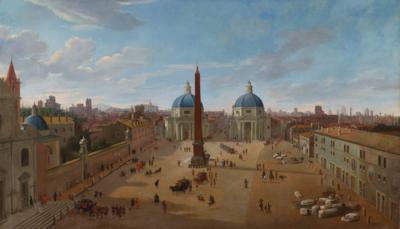Roman School, 18th Century
Piazza del Popolo with the Flaminio Obelisk, the twin churches of Santa Maria in Montesanto and Santa Maria dei Miracoli, Rome,
oil on canvas, 75 x 127.8 cm, framed
Provenance:
with T. Agnews & Sons (according to an old label on the reverse);
art market, Denmark;
where acquired by the present owner
The present composition depicts one of the most celebrated views of Rome, the Piazza del Popolo looking towards the twin churches of Santa Maria di Montesanto and Santa Maria dei Miracoli, built in the second half of the 17th century for Pope Alexander VII. In the centre of the piazza is the Flaminio Obelisk, an Egyptian monument from the time of Ramesses II, brought to the city at the time of Augustus and previously placed at the Circus Maximus, behind which can be glimpsed the fountain by Giacomo della Porta erected in the square in 1573 by Gregory XIII. On the left, part of the façade of the basilica of Santa Maria del Popolo is shown: the church, of medieval origin, stands on the site where Nero was buried and was remodelled several times over the centuries, first at the end of the 15th century and then in the mid-17th century by Gian Lorenzo Bernini, who gave it its present appearance. The view is animated by a large number of agile and lively figures, dressed in 18th-century clothing and caught in their daily activities, ranging from gentlemen in carriages to the beggar intent on begging on the steps of the basilica.
The pictorial genre of vedutismo developed widely in Rome in the 18th century and could represent both imaginary places (so-called ‘capricci’) and realistic views. The latter, to which the canvas presented here also belongs, proposed an ‘objective’ representation of places, also influenced by the spread of the new Enlightenment ideas. The initiator of the realistic view is identified in Gaspar Van Wittel, a painter of Dutch origin, who worked for a long time in Rome. During a stay in Venice, the artist produced a number of drawings of views of Venetian canals, which he later transformed into paintings, inaugurating a genre that enjoyed enormous success among collectors, especially among foreign visitors on the Grand Tour to Italy.
Expert: Mark MacDonnell
 Mark MacDonnell
Mark MacDonnell
+43 1 515 60 403
old.masters@dorotheum.com
25.10.2023 - 18:00
- Dosažená cena: **
-
EUR 33.900,-
- Odhadní cena:
-
EUR 20.000,- do EUR 30.000,-
Roman School, 18th Century
Piazza del Popolo with the Flaminio Obelisk, the twin churches of Santa Maria in Montesanto and Santa Maria dei Miracoli, Rome,
oil on canvas, 75 x 127.8 cm, framed
Provenance:
with T. Agnews & Sons (according to an old label on the reverse);
art market, Denmark;
where acquired by the present owner
The present composition depicts one of the most celebrated views of Rome, the Piazza del Popolo looking towards the twin churches of Santa Maria di Montesanto and Santa Maria dei Miracoli, built in the second half of the 17th century for Pope Alexander VII. In the centre of the piazza is the Flaminio Obelisk, an Egyptian monument from the time of Ramesses II, brought to the city at the time of Augustus and previously placed at the Circus Maximus, behind which can be glimpsed the fountain by Giacomo della Porta erected in the square in 1573 by Gregory XIII. On the left, part of the façade of the basilica of Santa Maria del Popolo is shown: the church, of medieval origin, stands on the site where Nero was buried and was remodelled several times over the centuries, first at the end of the 15th century and then in the mid-17th century by Gian Lorenzo Bernini, who gave it its present appearance. The view is animated by a large number of agile and lively figures, dressed in 18th-century clothing and caught in their daily activities, ranging from gentlemen in carriages to the beggar intent on begging on the steps of the basilica.
The pictorial genre of vedutismo developed widely in Rome in the 18th century and could represent both imaginary places (so-called ‘capricci’) and realistic views. The latter, to which the canvas presented here also belongs, proposed an ‘objective’ representation of places, also influenced by the spread of the new Enlightenment ideas. The initiator of the realistic view is identified in Gaspar Van Wittel, a painter of Dutch origin, who worked for a long time in Rome. During a stay in Venice, the artist produced a number of drawings of views of Venetian canals, which he later transformed into paintings, inaugurating a genre that enjoyed enormous success among collectors, especially among foreign visitors on the Grand Tour to Italy.
Expert: Mark MacDonnell
 Mark MacDonnell
Mark MacDonnell
+43 1 515 60 403
old.masters@dorotheum.com
|
Horká linka kupujících
Po-Pá: 10.00 - 17.00
old.masters@dorotheum.at +43 1 515 60 403 |
| Aukce: | Obrazy starých mistrů |
| Typ aukce: | Sálová aukce s Live bidding |
| Datum: | 25.10.2023 - 18:00 |
| Místo konání aukce: | Wien | Palais Dorotheum |
| Prohlídka: | 14.10. - 25.10.2023 |
** Kupní cena vč. poplatku kupujícího a DPH(Země dodání Rakousko)
Není již možné podávat příkazy ke koupi přes internet. Aukce se právě připravuje resp. byla již uskutečněna.

